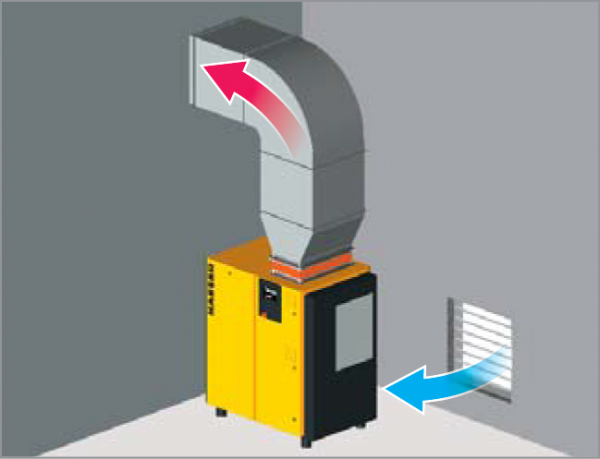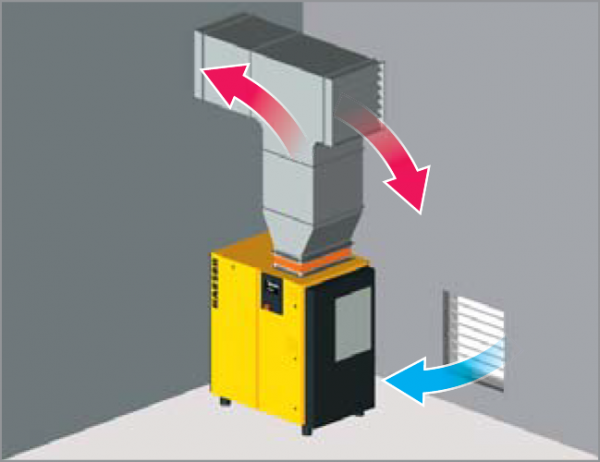Compressors convert 100 percent of the electrical power consumed into heat. Even a relatively small 18.5 kW compressor easily generates enough surplus thermal energy to heat a typical family home. This is why efficient cooling is essential for reliable operation of a compressed air system.
The exhaust heat generated by compressors is a perfect source of reusable energy. With the help of appropriate heat recovery systems, up to 96 % of the power consumed can be recovered as heat, and if this is put to good use it can significantly reduce the costs of com- pressed air production (see "Energy savings with heat recovery").
However, even where heat is recovered, the compressor still needs an effective cooling system. The costs for air cooling can be up to 30 percent lower than those for water-cooled systems. This is why air-cooled systems should be given preference wherever possible.
1. The compressor environment
1.1 Clean and cool is best
One of the main requirements of health and safety regulations is that compressors must be installed in such a way as to allow adequate accessibility and sufficient cooling. Regulations for the installation of compressors require that ambient temperatures for the operation of air and oil-cooled compressors may not exceed +40 °C.
Regulations also state that dangerous substances must never be released near compressor intake areas. These regulations stipulate just the minimum requirements. Their purpose is to keep the risk of accidents as low as possible. Efficient compressor operation with minimal maintenance requirement, however, demands a lot more.
1.2 The compressor room is not a storage area
A compressor room is not a storage area and should be kept free of dust and other contaminants, as well as extraneous equipment that has nothing to do with the production of compressed air; the floor should also be non-friable.
Under no circumstances may air be drawn in to the compressor room from a dusty or otherwise contaminated environment unless intensive fitration is used. But, even under normal operating conditions, intake and cooling air should be cleaned with appropriate filters.
1.3 A suitable and constant temperature
Temperature has a considerable influence on the reliability and maintenance requirements of compressors; inlet and cooling air should be neither too cold (+40° C). This must be taken into account in the planning and installation phases. For example, summer sun shining on south or west-facing walls of a building can increase the room temperature considerably.
Even in temperate climate zones room temperatures can reach over +40 °C. This is why apertures for cooling and inlet air should be located in shaded walls and not in direct sunlight. The size of the apertures is related to the capacity of the compressors installed and to the method of ventilation used.
2. Ventilating the compressor room
No matter whether using planning and installation phases air or water-cooled compressors, adequate compressor room ventilation is essential. Whatever the case, heat radiated within the compressor package from the air end and electric motor has to be extracted from the room. This corresponds to approximately 10 percent of compressor drive power.
3. Various methods of ventilation
3.1 Natural ventilation
Cooling air is drawn into the room by the compressor fan, the air is heated as it passes over the compressor and rises upwards, leaving the compressor room through an aperture placed near the ceiling (Fig. 1).

This kind of ventilation can only be recommended, however, for use in exceptional cases and for compressor powers below 5.5k W, since even sunshine or wind pressure on the exhaust aperture can cause problems.
3.2 Forced ventilation
This method uses a forced flow of cooling air. Ventilation is thermostatically controlled to prevent the temperature in the compressor room from falling below +3° C during colder times of the year. Low temperatures negatively impact the performance of the compressors, the condensate drains and the air treatment equipment.
Thermostatic control is necessary because with forced ventilation the compressor room is subjected to slight negative pressure that prevents back- fl ow of hot air into the room. There are two methods of forced ventilation:
3.2.1 Ventilation with an external extractor fan
A fan installed in the exhaust aperture of the compressor room and fitted with a thermostatic control (Fig. 2) exhausts the heated air.

An important requirement for this type of ventilation is that the cooling air inlet aperture is of sufficient size (see lower right in the illustration); if it is too small, it could cause too high a vacuum resulting in increased noise from excessive air- flo w speeds. In addition, cooling of the compressed air station would be endangered.
The ventilation should be designed to restrict the temperature rise in the room caused by waste heat from the compressor to 7 K above inlet temperature. Otherwise heat will build up and cause a compressor breakdown.
3.2.2 Ducted ventilation
Modern, fully encapsulated rotary screw compressors provide an almost ideal way of ventilation by means of exhaust ducting. The compressor fan draws in cooling air through an appropriately sized aperture and discharges it into a duct that takes it straight out of the compressor room (Fig. 3).

The principal advantage of this method is that the temperature of the cooling air may be allowed to rise significantly higher, to approximately 20 K above ambient. This reduces the volume of cooling air needed. Normally, the cooling fans fit ted in the packaged compressors have sufficient residual thrust to drive the cooling air through the ducting and out of the room.
This means that in contrast to ventilation with an external extractor fan no additional energy is required. This applies only, however, if the residual thrust of the fans is sufficient for the ducting used. Ideally, the exhaust duct should be provided with a thermostatically controlled flap (Fig. 4) to direct hot air into the compressor room in winter to maintain proper operating temperatures.

If air-cooled dryers are also installed in the compressor room then the compressor(s) and dryer(s) should not influence each other’s ventilation air flows. At temperatures above + 25° C it is recommended to increase the cooling air fl ow rate by running a supplementary thermostatically controlled fan in the ducting for the refrigeration dryers.